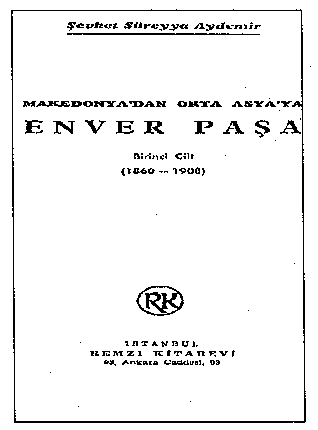
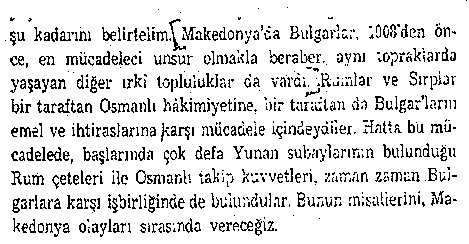
IV. Memoires of the Turkish national hero Enver Bey (Enver Pasha).
Appendix No 20 contains the phrase: „Prior to 1908, the Macedonian Bulgarians were the most militant element..." (page 372 in the Turkish edition).


Appendix No 21 has the following acknowledgement: „Since the Bulgarians were the most important and the most energetic element, the Macedonian question, with all its gravity, was a Bulgarian question" (page 434).
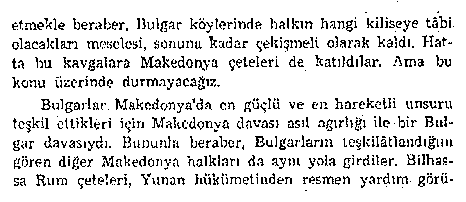
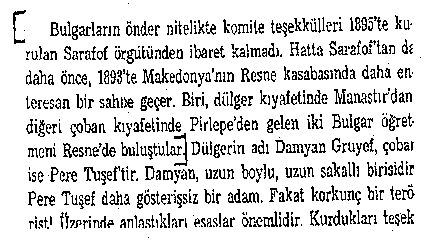
Appendix No 22 gives information about the formation of the Internal
Macedonian Revolutionary Organisation (IMRO). There it points out the unflinching
Turkish conviction that the creator of this Organisation was Damyan Gruev,
a Bulgarian and Bulgarian teacher in Macedonia. The same is said about
the other great tighter, Pere Toshev from the city of Prilep. While Gruev
was born in the village of Smilevo not very far from Bitola (page 435 in
the original).
This Turkish evidence undermines the Serbo-Macedonist propaganda claim saying that Gruev and the rest of the Macedonian Slavs are not Bulgarians but some kind of another nationality unknown to anyone in the world since the 12th century.
Appendix No 23 contains the following phrase: „The outrages against
the Turks, against the foreigners, the bombing of railroads and bridges,
in the cities, countries and all other possible places all such disorders
and outrages, according to the Macedonian Revolutionary Organisation, would
indicate to the Europeans
that the Ottoman state was unable to govern in the Balkans. The Ottoman
government was subject to attacks in many different ways and, indeed, it
would have remained powerless. As a consequence the Macedonians would have
had the say-so, more specifically the Bulgarians" (page 438).
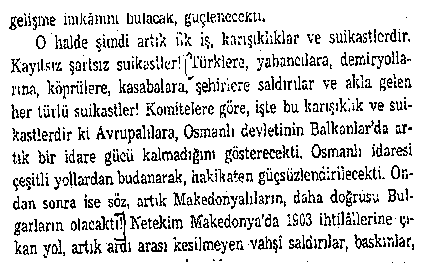
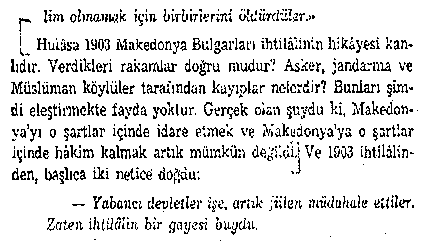
Appendix No 24 contains the following passage: „Briefly, the insurrection of the Macedonian Bulgarians was a bloody history. Is the given statistical information true? What were the losses of the army, the gendarmes, and Moslem villagers? It is useless to delve into these questions. Indisputable was the fact, that under such conditions it was no longer possible to govern Macedonia“ (page 452).
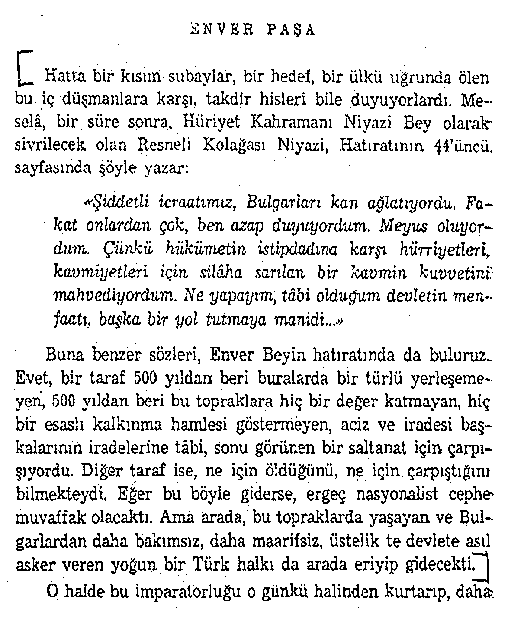 Appendix No 25 has the following words; „Even a part of the officers began
to respect their enemies of the interior, who were dying for a holy cause.
For example, the Resen company commander Niazi Bey who was subsequently
proclaimed a hero of the Young Turks revolution, on 44 pages of his Memoirs
writes: „The cruelties of our administrative authorities were bringing
the Bulgarians to bloody tears. However, I was suffering more than they.
I was giving. It was because I was crushing the strength of a people which
had armed itself against the terror of the state of which I am a servant
was preventing me from taking a different course...“
Appendix No 25 has the following words; „Even a part of the officers began
to respect their enemies of the interior, who were dying for a holy cause.
For example, the Resen company commander Niazi Bey who was subsequently
proclaimed a hero of the Young Turks revolution, on 44 pages of his Memoirs
writes: „The cruelties of our administrative authorities were bringing
the Bulgarians to bloody tears. However, I was suffering more than they.
I was giving. It was because I was crushing the strength of a people which
had armed itself against the terror of the state of which I am a servant
was preventing me from taking a different course...“
We find also similar statements in the Memoirs of Enver Bey. Yes, a country was fighting for a domination whose end was visible, because in the course of 500 years it did not invest any capital in Macedonia for its welfare and did nothing for its city planning; it was a domination with weak will and under the influence of foreign desires.
While our internal enemy knew what it was fighting and dying for, and the situation should continue, inevitably, sooner or later, the nationalistic front would have succeeded. However, along with the disintegration of the government the Turkish population living in that country would have perished. They were supplying the state with good soldiers“ (page 456).
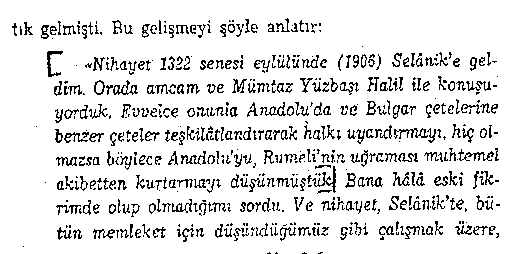 Appendix
No 26 gives quotations from the Memoirs of Enver Bey in which he points
out his views and those of his uncle Halii Bey, that in Asia Minor there
should be created chetas (armed groups of people) similar to those of the
Bulgarians in Macedonia, to fight against the Sultan’s regime (page 501).
Appendix
No 26 gives quotations from the Memoirs of Enver Bey in which he points
out his views and those of his uncle Halii Bey, that in Asia Minor there
should be created chetas (armed groups of people) similar to those of the
Bulgarians in Macedonia, to fight against the Sultan’s regime (page 501).
Note: And here again I must emphasise the fact that they speak only
about chetas of the Bulgarian nationality in Macedonia, and not some kind
of non-existent at that period nationality as „Macedonian“ one.

Appendix No 27 among other things states: „Our regular cheta already
consisted of eight persons. I was trying to stir up the citizens of Veles.
Speaking to them, I pointed out as an example the Bulgarians who had the
most popular and active revolutionists all from Veles. On July 9, (1908)
at 6:30 P.M. I entered Veles" (page 562).
 Appendix
No 28 gives a description of Enver Bey’s entrance into Veles, a city of
about 20,000 population, three-fourths of which are Bulgarians.
Appendix
No 28 gives a description of Enver Bey’s entrance into Veles, a city of
about 20,000 population, three-fourths of which are Bulgarians.
In the marked lines it is stated: „The hour has arrived...
As the representatives of the Muslims and Christians gathered at the
City Hall, so did the people and the Army. As Enver Bey appeared on the
terrace with his retinue, the people became ruffled and began shouting:
Long live the fatherland! Long live the people!
Until this day such words and voices were not heard. These shoutings
were filling the atmosphere. First one of the hodjas (Mohammedan priest)
read a prayer. After that Rev. Gyoshev, one of the Bulgarian priests, delivered
a touching speech in the Bulgarian language. The final word, however, was
said by Enver Bey. This is how he described the moment:
„I took the floor.delivered two speeches - one in Turkish and one in the Bulgarian language“ (page 563).
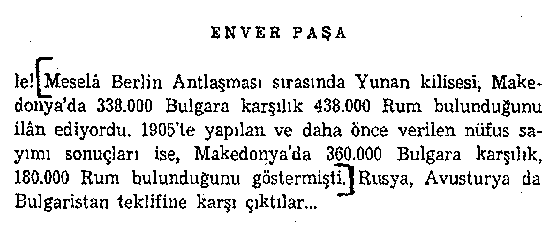 Appendix
No 29 in the lines within the parenthesis points out: „During the time
of the Berlin Conference (Congress of Berlin, June 13, 1878) the Greek
Church announced that in Macedonia there are 438,000 Greeks, and only 388,000
Bulgarians. During the census of 1905 it was established that there were
360,000 Bulgarians and only 180,000 Greeks“ (page 440).
Appendix
No 29 in the lines within the parenthesis points out: „During the time
of the Berlin Conference (Congress of Berlin, June 13, 1878) the Greek
Church announced that in Macedonia there are 438,000 Greeks, and only 388,000
Bulgarians. During the census of 1905 it was established that there were
360,000 Bulgarians and only 180,000 Greeks“ (page 440).
It has no bearing on the problem of this brochure as to how much they
reduced the number of the Bulgarians in Macedonia in both of the above
statistics. The important thing is that both of them
recognise the Bulgarian nationality there, rather than some kind of
a non-existing Slavic nationality as has recently been decreed in Communist
Yugoslavia and by the Serbo-Macedonists in nowadays Republic of Macedonia.
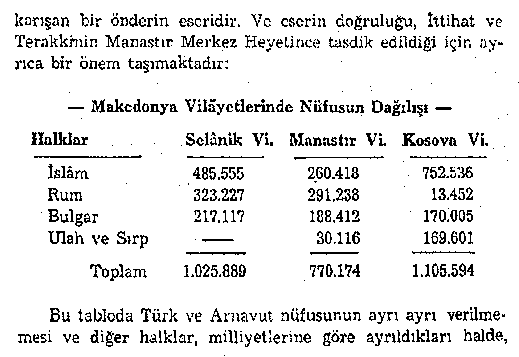
Appendix No 30 contains a Turkish statistic which the Young Turk hero
Niyazi Bey included in his Memoirs about the time of 1908. In this statistic
are given (for the three Vilaets: Salonik, Bitola and Kosovo) altogether
570,534 Bulgarians (page 425). And even here the number of the Bulgarians
is greatly reduced, while those of the Greeks are doubled. What is really
important, as pointed out in Niyazi Bey’s brochure, is that even according
to him the Slavs in Macedonia are Bulgarians.
[Previous] [Next]
[Back to Index]